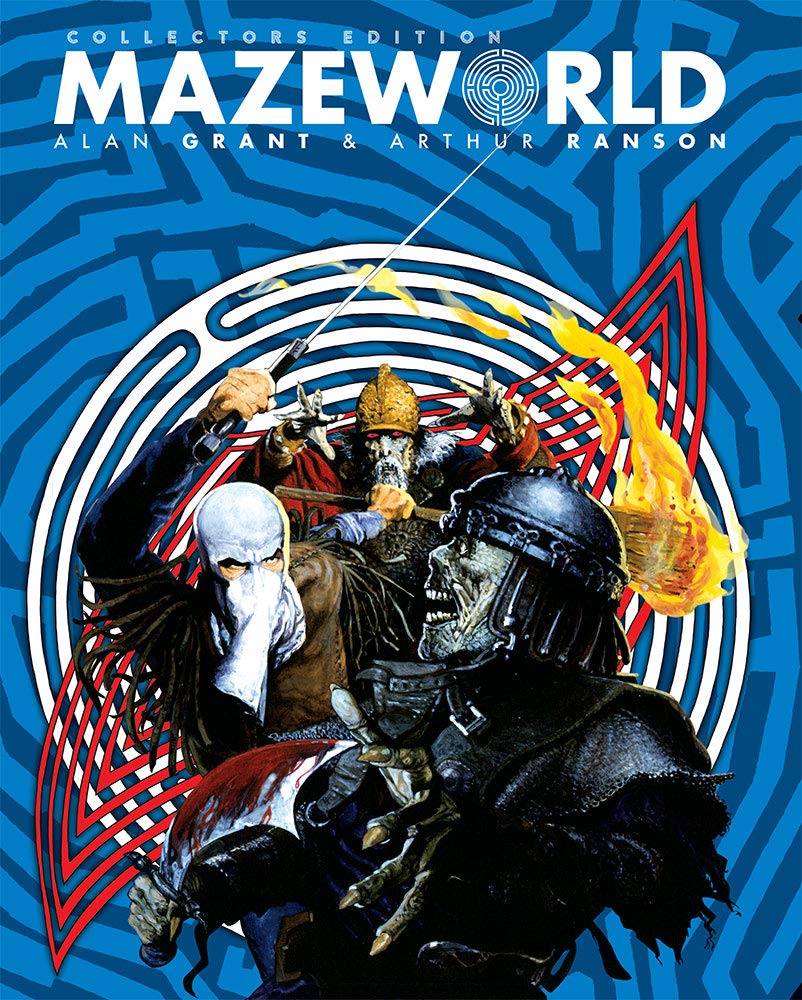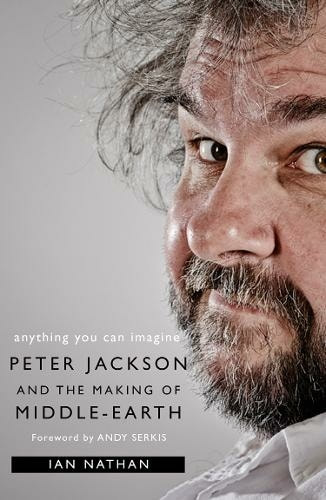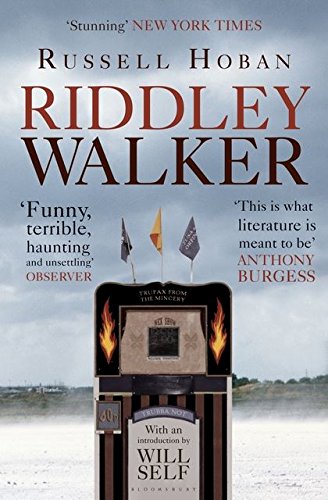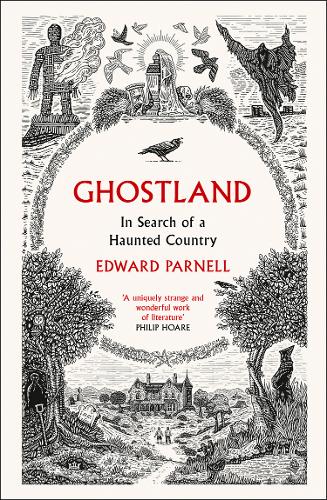|
Britain has brought back the death penalty, and Adam Cadman, convicted of murder, finds himself the first person to be hanged since 1964. But as the noose tightens around his neck, Cadman is transported to the Mazeworld, a world in another dimension, and there this reluctant hero begins his adventure. For in this world of strange creatures and mighty warriors, Cadman is believed to be the Hooded One, a hero of old who can lead the oppressed masses in rebellion against the Mazeworld’s cruel masters… It’s been a long time since I last dipped into the wild and weird world of 2000AD; although not a regular reader of the comic as a young person, characters such as Nemesis the Warlock left an indelible memory. I decided to start my journey through 2000AD classics with Mazeworld, and I was not disappointed. Written by Alan Grant and illustrated by Arthur Ranson, Mazeworld is truly a work of epic fantasy, bold and imaginative. There is action aplenty, all expertly paced and beautifully illustrated – the artwork of Arthur Ranson is always stunning and at times simply breathtaking. Some of the panels could be frames from epic movies, full of energy and excitement. It is a powerful story too, thematically dense, and rich in mythological and folkloric imagery such as the Green Man. The world building is staggering - the architecture of this other dimension, inspired by the Aztec and ancient Egyptian cultures, looms over the panels, almost making the Mazeworld a character in its own right, with visual treats such as the enormous ziggurats, the many carved monuments to old gods who look on in silent judgement, and the twisted alleyways and dungeons. The gritty rundown realism of the Mazeworld plays effectively alongside the broader fantasy elements such as maze monsters and flying lizards – this serves to make the world of the story all the more convincing and immersive. Cadman is certainly far from the traditional hero – upon his first ‘arrival’ in the Mazeworld he is a coward, concerned only with his own welfare and interests; but gradually, through many trials and failures, he begins to develop into the hero the suffering folk of the Mazeworld so desperately crave. Mazeworld offers an unsettling vision of evil - the enemies Cadman face in this other dimension are truly horrific, from the scheming Lord Raven, to the spine-chilling Dark Man with his deadly third eye, and the final demonic foe… Atmospheric and immersive, Mazeworld is a treat for any lover of fantasy fiction and tales of the uncanny. I was so engrossed in the unfolding plot, I am sure there are many subtleties I missed, so I look forward to discovering them when I re-read the book and once more become lost in the Mazeworld. If you want find out more about Mazeworld, I'd recommend an excellent short introductory video made by 2000AD:
4 Comments
Book review: Anything you can imagine - Peter Jackson and the making of Middle Earth, by Ian Nathan7/5/2021 I can vividly remember the first time I watched The Fellowship of the Ring – in a packed cinema, with an excited and expectant audience. I’d been counting down the weeks, the days, the hours to the opening of the film. I’d long been a huge admirer of J.R.R. Tolkien’s work, and a trilogy of films based on The Lord of the Rings was something I’d dreamed of for years. However, my excitement was tempered by a twinge of trepidation – surely no film could truly capture the depth of Tolkien’s epic, surely no-one could bring Middle-Earth to life on the screen? Well, with Frodo and friends in Peter Jackson’s safe hands, I need not have feared. Like millions of others, I was enthralled by The Fellowship of the Ring – a film beautifully designed and superbly acted, with moments that chimed perfectly with the book, such as the bucolic Shire, the fearsome Black Riders and the film’s (arguably the trilogy’s) highlight sequence, the Mines of Moria, especially the mighty Balrog. As soon as The Fellowship of the Ring ended, I wanted to see it again, and of course, looked eagerly forward to seeing The Two Towers and The Return of the King, both of which proved to be sublime cinematic achievements in their own right. Anything you can imagine tells the story of how these wonderful films came to be made, and it is a fascinating tale. The book gives insights into the lengthy and complex creative process, as well as the Byzantine twists and turns of the film industry. The journey of the film from Peter Jackson’s and Fran Walsh’s initial idea of adapting The Lord of the Rings to the final, final green light for the project is deeply interesting, a winding route encompassing King Kong, Miramax and the Weinstein brothers (shudder), to the dramatic intervention of New Line Films, and their bold, unprecedented decision to make three films back-to-back. It almost reads like a thriller and one can only admire the tenacity of Jackson and his colleagues to bring the project to fruition where surely many others would have given up.
Nathan also superbly tracks the fascinating ascent of Peter Jackson from maverick, self-taught director of low budget splatter films, through to the blossoming of his talent in pictures such as Heavenly Creatures, to eventually becoming one of the world’s most successful movie-makers. Once the book moves into the nuts and bolts detail of actually making The Lord of the Rings film, I found it lost a little of its focus and strong narrative, but it always remains highly readable and reflects the enormous challenges and sheer scale of creativity involved in bringing the films to life. From the groundbreaking special effects (such as the MASSIVE software used to help portray the epic battles, and the creation of Gollum), the stunning sets, and the music of Howard Shore, truly one of the great triumphs of the film trilogy, the scale of what was accomplished, often pushing film-making into new areas, becomes clear. Peter Jackson is the conductor of this great orchestra, but Nathan rightly makes sure credit is given to the many others, especially his redoubtable fellowship of Kiwi collaborators, who surmount problem after problem, refuse to submit to the project’s many naysayers, and doggedly drained every last ounce of creativity and energy to make the best possible version of Tolkien’s masterpiece. The book treads more lightly on the generally less-loved The Hobbit trilogy, but gives an absorbing insight into the legal, logistical and creative issues in the troubled gestation and production of these films. And for all the flaws of The Hobbit trilogy, and I confess they leave me a little cold, Nathan rightly acknowledges their successful elements, such as the performances of Martin Freeman and Ian McKellen, the often stunning visuals, and the memorable depiction of Smaug. It’s difficult to imagine a more daunting cinematic journey to document than The Lord of the Rings trilogy, but Nathan succeeds with flair and humour, and his passion for these films, and for cinema in general, shines through on every page. I’d strongly recommend Anything you can imagine for anyone interested in The Lord of the Rings films or just in movie-making in general. And having read this book, I now want to watch and enjoy all three films (extended editions, of course) all over again… “On my naming day when I come 12 I gone front spear and kilt a wyld board he parbly ben the las wyld pig on the Bundel Downs any how there hadnt ben none for a long time befor him nor I aint looking to see none agen.” Just from this quote – the opening words of the novel – you will see Riddley Walker is a book unlike any other. The novel is set hundreds of years in the future, long after a nuclear holocaust, with England reduced to effectively an Iron Age level of existence. When his father dies in an accident, young Riddley Walker inherits a shamanistic role among his people, and when he uncovers an attempt to recreate the weapons that once devastated civilization, he is forced to go on the run. Twelve years’ old, though perceptive beyond his tender years, Walker narrates his adventure in the fragmented, fractured Riddleyspeak, a language as broken as the society portrayed in the story. I found Riddleyspeak a challenge, especially in the early pages, but in time (and with the help of a glossary at the end of the book), I began to adapt to the rhythm and structure. You are forced to slow your reading, and if anything, I think the book would benefit from being read aloud.
The language reinforces the sense we are seeing Riddley’s post-apocalyptic world through his eyes, adding to the force and energy of his descriptions. Hoban’s invented language fizzes with clever word-play, and through this we see echoes of the past, and adds to the sense shared by Riddley and other characters in the story of the heights civilization once reached, and the bitterness and sense of shame that all was lost through human aggression and greedy misuse of their technological wonders. The language can, in places, be very funny, for example in the twisted Kent placenames (Do-it-over = Dover, Horny Boy = Herne Bay) and the scene where Goodparley and Riddley attempt to interpret The Legend of Saint Eustace (written as it is in modern English). Riddley’s adventurous journey allows Hoban to build a grim portrayal of this ruined England, from the mysterious Eusa folk, the ruined cathedral in Cambry (Canterbury), the wandering packs of wild dogs and the Eusa Show, performed by the ‘Pry Mincer’ and the ‘Wes Mincer’, who on their travelling puppet shows perform allegorical propaganda stories to the , communities. It is an uncompromising vision, and as bleak and well-conceived a dystopia as I have ever encountered. Infused with mythological, folkloric and religious symbolism, Riddley Walker is rich for endless interpretation; it is not an easy read, but it is worth the effort – Trubba not. I would also add the edition of Riddley Walker I read had an entertaining introduction by novelist Will Self, which provided some valuable insights and context. If you spend any time in the lonely places of the British countryside – the deserted beaches, the dense forests, the Fens, the hills and mountains, the still ponds and lakes, the ruins half-swallowed by time – then you’ll be familiar with the occasional fleeting sense of there being something just out of sight, just out of hearing, a sense of watchfulness, of secrets and trauma long-hidden. It is these wild places, and the effect they have on us, that Edward Parnell explores in his outstanding book Ghostland – In search of a Haunted Country. In the best way, Ghostland is a difficult work to categorize. It is a book of haunted landscapes and haunted lives, a book filled with folklore, natural history, psychogeography and cinematic and literary references, all underpinned by the author’s deeply moving personal story. Whether exploring the crumbling cliffs and lonely beaches of Suffolk, or the sprawling Glasgow Necropolis, or the rugged coast and Neolithic moorlands of West Cornwall, and many locations in between, Parnell invokes a powerful sense of place and the stories and ghosts that surround and infuse them. Ghostland shines a light on some of Britain’s finest writers of horror and the uncanny, such as M.R. James, William Hope Hodgson, Arthur Machen and Alan Garner, showing how their obsessions and fears, and connections to their landscape, shaped their creations, often in unsettling ways. Although some of the authors mentioned in the book I am familiar with, there are others whose work I didn’t know, so one of the joys of Ghostland is discovering a list of novels and short stories I now can’t wait to read.
As well as ghostly literary tales, on-screen horrors are explored too, and not just folklore-inflected cinema and television such as The Wicker Man, The Children of the Stones and Jonathan Miller’s peerless M.R. James adaptation Whistle and I’ll Come To You (still an intense, disturbing experience), but also the dark strain of British public information films, which are vividly remembered, most likely in our personal and collective nightmares, by the generation exposed to them. For example, Lonely Water, a nightmarish warning of the perils of swimming in dangerous places (narrated with spine-tingling relish by Donald Pleasance), and Apaches, a terrifying short film I remember being shown at primary school – if the aim of Apaches had been to convince children growing up in rural Britain in the 1970s and 1980s that the countryside was filled with hidden and gruesome threats, then, from my perspective at least, it succeeded… I think anyone reading this book will find some moments of connection and resonance, whether in Parnell’s deep love and reverence for the natural world, his fascination with stories of the uncanny or in his sensitive but unflinching description of his own personal tragedies. For me, Ghostland demonstrates how our cherished places and stories – in any form – can help us manage and make sense of our real-life struggles. The best ghost stories don’t just frighten or excite us, they help to remind us to acknowledge painful memories – our own ghosts of the past – to help us move forward, to help us keep going, even when stricken with loss and grief. From the first page of Ghostland to the last, I fell under its haunted spell; I have no doubt it is a book I will revisit and reread, and I am sure every time I open it, I will find new treasures – and new horrors – buried within its pages. |
Archives
October 2023
Categories
All
|




 RSS Feed
RSS Feed